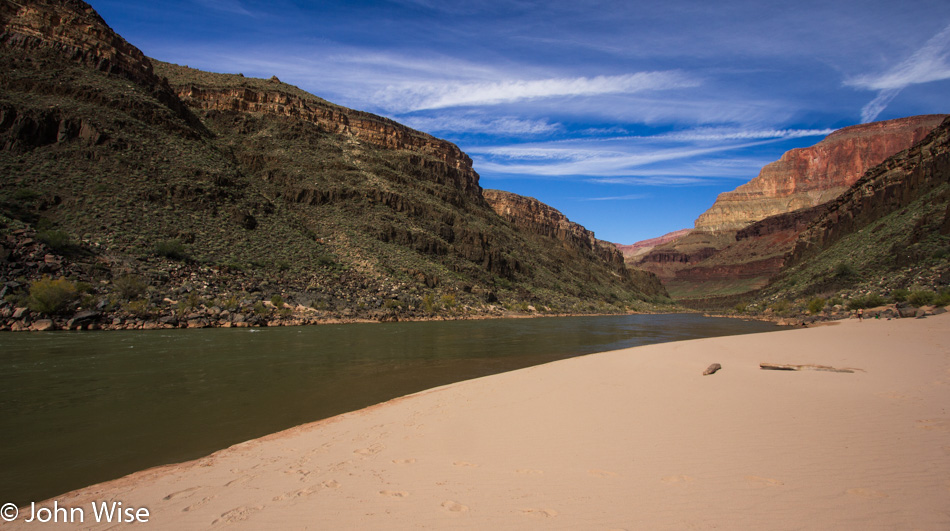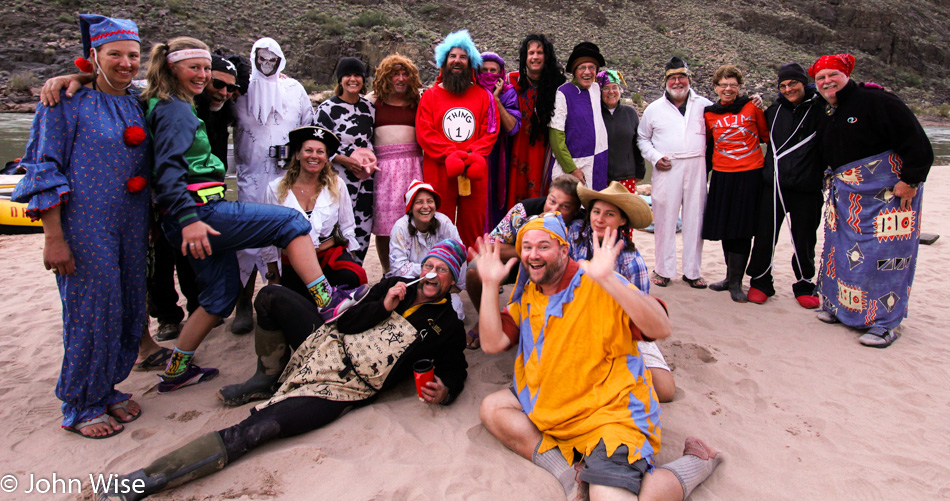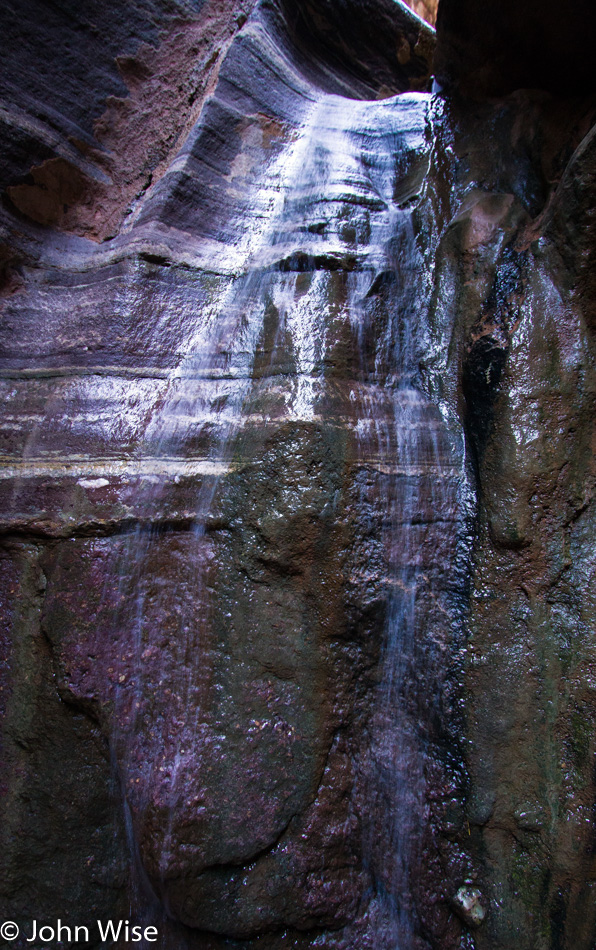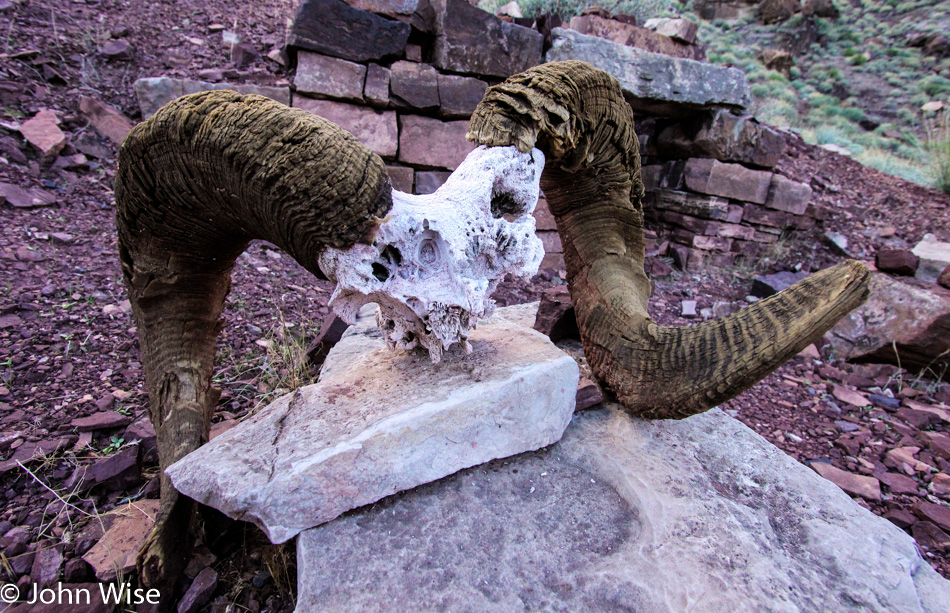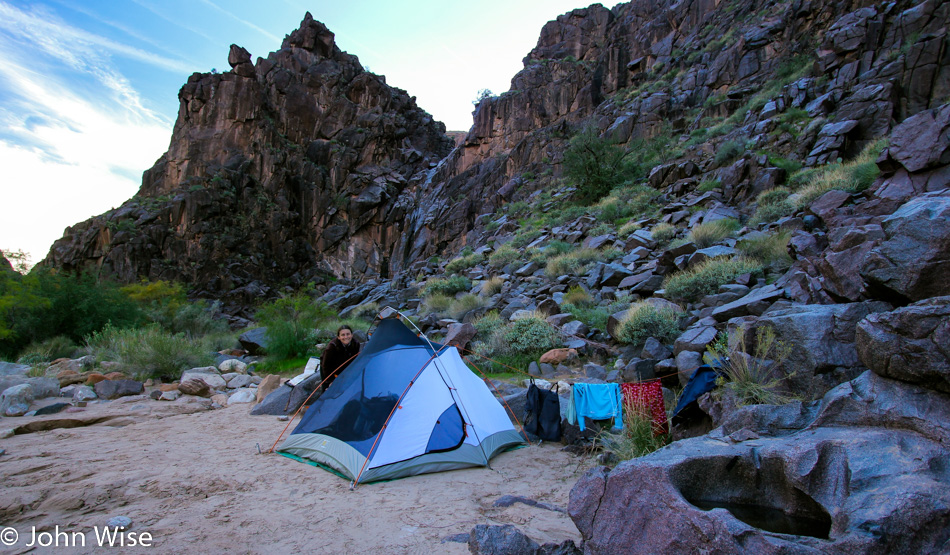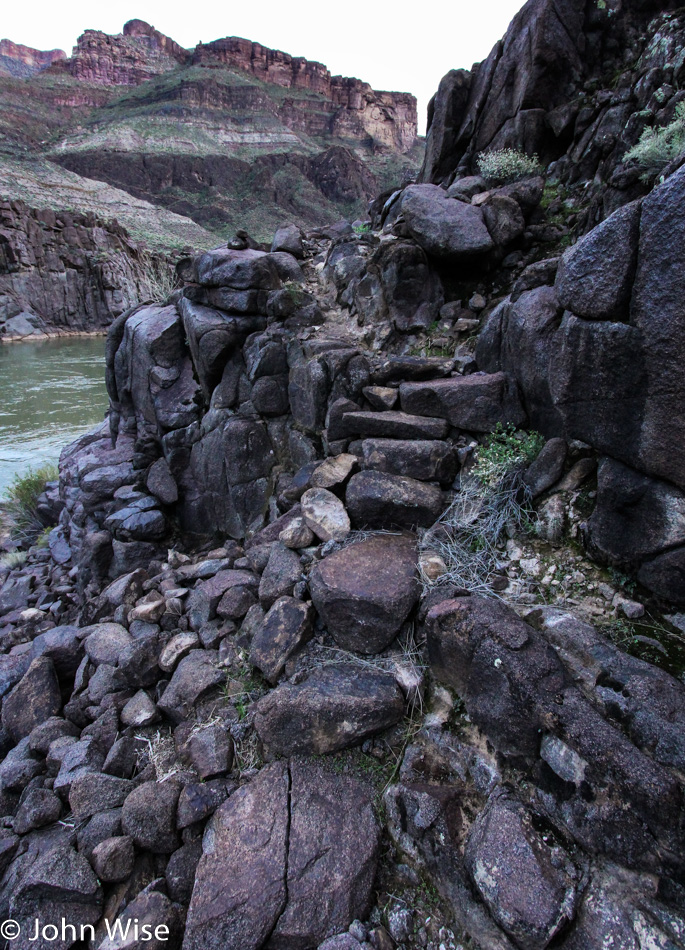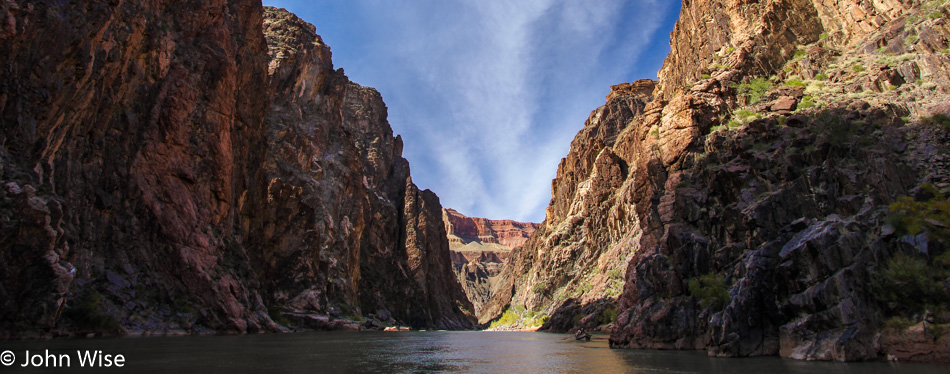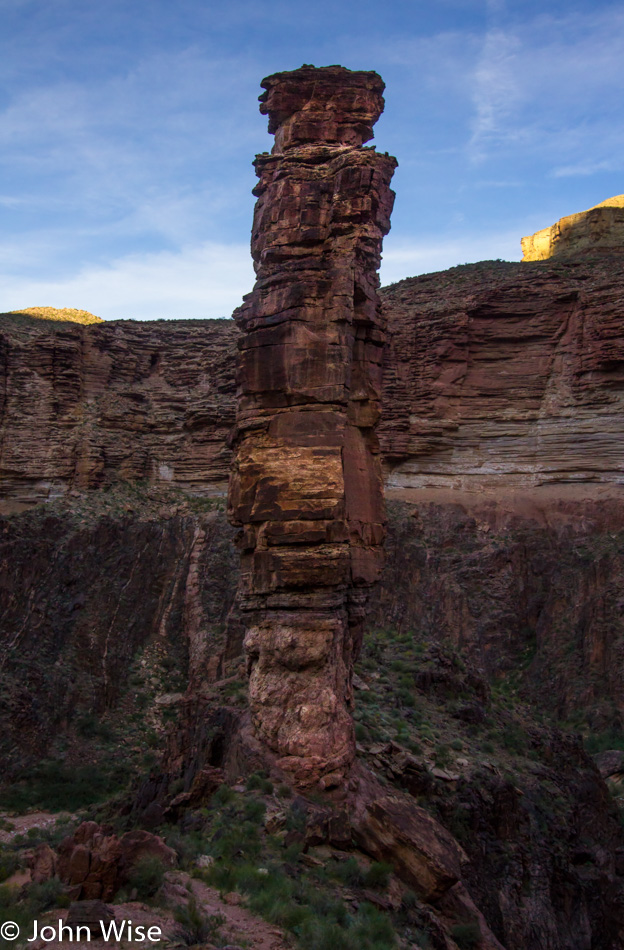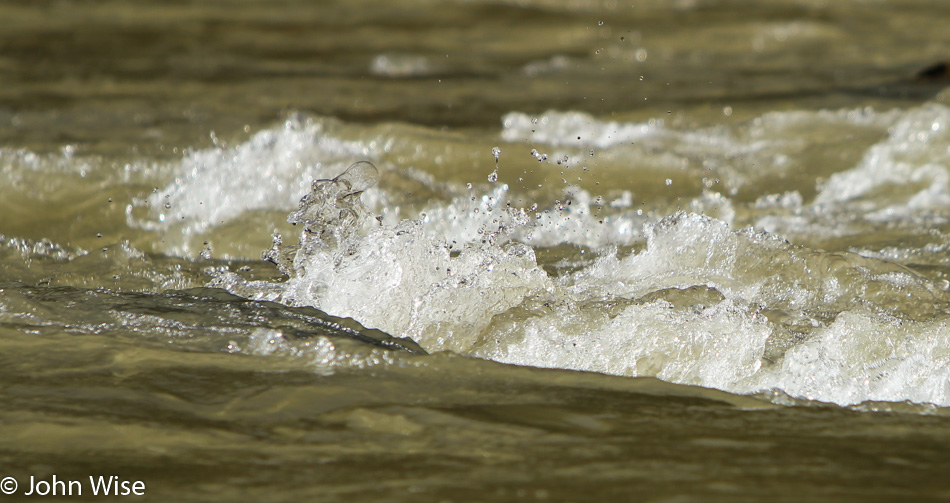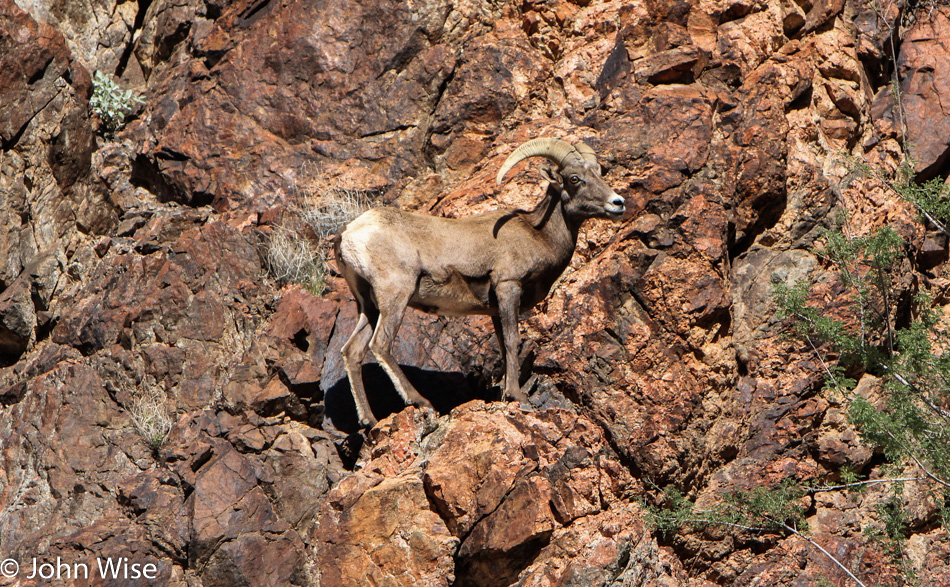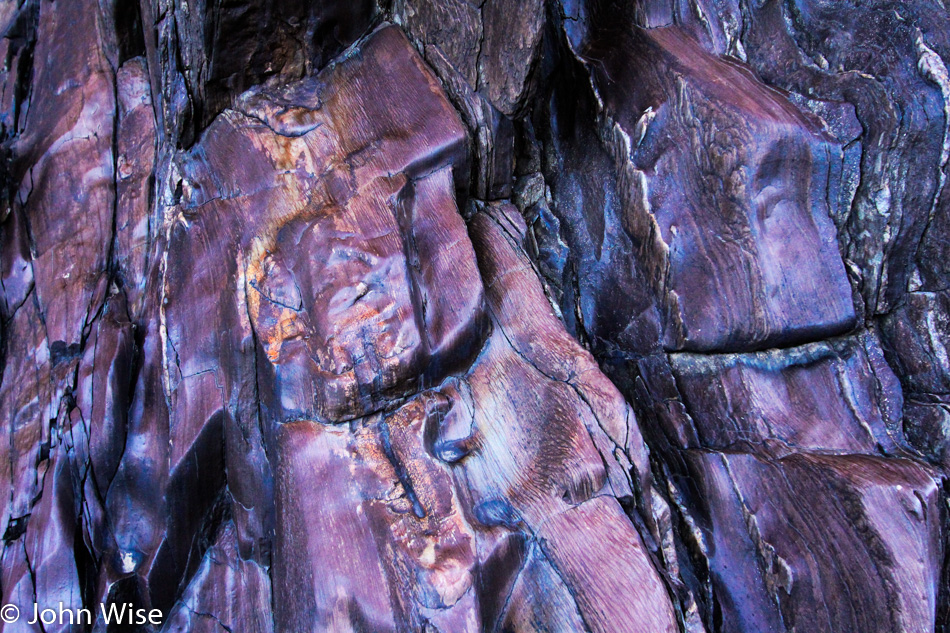The real pleasure of a layover day is not that we will avoid risking life and limb on the river; it is that we do not have to break camp. No rolling up sleeping bags, no pulling down tents, and shaking sand from their interior. The dry bags stay put; the laziness of it all is a great indulgence. With that in mind, this would also be a day to sleep in. Cozy and warm, snuggled into the sack. A morning to linger in dreams.
Ring…Ring…Ring, it’s the bladder calling.
“Go away, let me doze a few more minutes,” I beg.
“Hey John, you awake? Is that the sun coming up? It makes me feel heavy and bloated.”
“NO, not yet; I’m cozy and oh-so warm. Can’t this wait?”
“I think I hear others stirring; it has me feeling like I want to be emptied; I’ll bet that’s what everyone is doing; come on, let’s go.”
“You can’t be serious. Why, on this one day when I get to sleep in, are you barging in with such an unreasonable demand?”
“I can hear water joining other water; is that splashing? You know what this does to me. Come on, let’s go.”
The indignity of being manipulated by a tiny 1.5-ounce organ that has the ability to put such pressure on me. I start to peel out of the bag of comfort. Seems Caroline’s bladder was having similar negotiations with her as she, too, unzips the cocoon for the trip to the river. Dressed, it’s time to take the bladder for a walk. Relief is at hand.
“Thanks, bladder.”
“No problem, now let’s get busy refilling me.”
Time for the first coffee of the day.
Dring….Dring….Dring…
“Hello.”
“Hey buddy, it’s me, the stomach. I swear that bladder was so full I could hardly breathe up here, making it hard to tell you how empty I am.”
“Yeah, don’t worry, I know the routine.”
“So, how about sending down a morsel or two?”
“Come on now, I’ve been telling you this for days: the kitchen is not ours to raid. There is no bakery around the corner, and we didn’t bring a stash of granola bars. You’ll have to wait.”
“But…but…um, this isn’t fair. Growwwl!!”
“Hey, that’s enough of that. Don’t make me get more coffee and fill bladder again to shut you up.”
“Okay, no need to get all angry with me. You know how sensitive I am. I think we both are well aware how that big mouth up there doesn’t like me dis-engorging myself, pushing the flow of bile into reverse.”
“Sorry, I’ll chill, stay calm. Oooh, what’s that over on the griddle? I think I see blueberry pancakes and bacon.”
“Bring it on, John, stuff that pie hole with syrupy goodness and crispy hog. I’m ready to get to work.”
“Hey guys, is all this commotion necessary?”
Jeez, here come the intestines.
“Yo up there, you have the experience to know I can weather the weight of bladder leaning up against me, but that fat-ass stomach is too much.”
“Who you calling fat, you shit sock? Take this; I’ll fill your big trap and shut you up fast. Mmmmm, isn’t that yummy? All that masticated pig, sugar, and dough, get down in there.”
“Go on and keep on pushing, flubby. It’ll only be minutes of this kind of abuse before I rush over and beat on the door of rectum, and John cleans all of us out.”
Just then, rectum takes the mentioning of his name to be roused from slumber, letting off a lazy yawn. Startled, Caroline asks, “What was that?”
“I don’t know, it wasn’t me.”
With that, it was now time to wake from the dream, crawl out of the toasty sleeping bag for real, and start the day. After breakfast, we returned to the kitchen to prepare a sack lunch as the crew was taking the afternoon off. Our picnic packed up, water bottles full, and river shoes strapped on tightly; it is departure time for those of us following Jeffe up Stone Creek Canyon.
As is the routine, the hoof up the trail was not designed for timid slowpokes. This early in the morning, with the majority of the side canyon in shadow, it doesn’t much bother me that we are racing along. I suppose this sprint is an artifact of summer when groups visiting the Canyon must get out early to avoid the heat of the day while trying to get to a destination with enough time to return before the blistering late afternoon wallops hikers with heatstroke. There could be another explanation that is perfectly reasonable, too, which is that our trip isn’t infinite. With a fixed number of days, there is only so much that can be seen. Add to this that our daylight hours are shortened due to the time of year, and it’s probably prudent, from the perspective of our guide, that we should get back to camp before dark.

As logical as this might sound in explaining the speed and time constraints, I still want to find the 120 Days of Pure Indulgence Canyon Adventure and sign right up. My ideal river tour of the Colorado wouldn’t be 120 consecutive days, though. I live in Phoenix, and I know how hot it can be in the Canyon come the middle of July. My dream trip leaves April 1st, putting in at Lees Ferry. For the next 60 days, we only travel a mile and a half on the river per day. This might allow enough time to explore all the side canyons and hang out, examine stuff, look into details missed by everyone else speeding down the river, and remember that there are no awards for those who finish first. After inspecting every nook and cranny, looking underneath rocks and grains of sand, deciphering patterns and clouds, memorizing all the river stories, and living some new ones, two months have passed, and we start our hike out at Phantom Ranch at the end of May, it’s Memorial Day.
The next 90 days are spent in air-conditioned bliss back in Phoenix while reveling in the memories of where we have been and looking forward to our return. Then, a week after Labor Day in early September, to avoid the remnants of the summer crowds, we fix our aim on the North Kaibab Trail for a return to Phantom Ranch. September and October in the Canyon will feel like coming home. This leg of the trip we’ll have to push along at a brisk two-and-a-quarter miles per day to take out at Diamond Creek a few days after Halloween. Maybe then, after such an extended stay in the company of the Colorado, I will start to feel something more than the vaguest familiarity with this place. But then again, I’ll probably still fall short when I consider that Harvey Butchart spent 1,024 days in the Canyon over many a year, hiking over 12,000 miles within these walls and climbing 83 of the Canyon’s summits. I will have to come to grips with the idea that no one will ever really know the extent and absolute detail of this beautiful land.
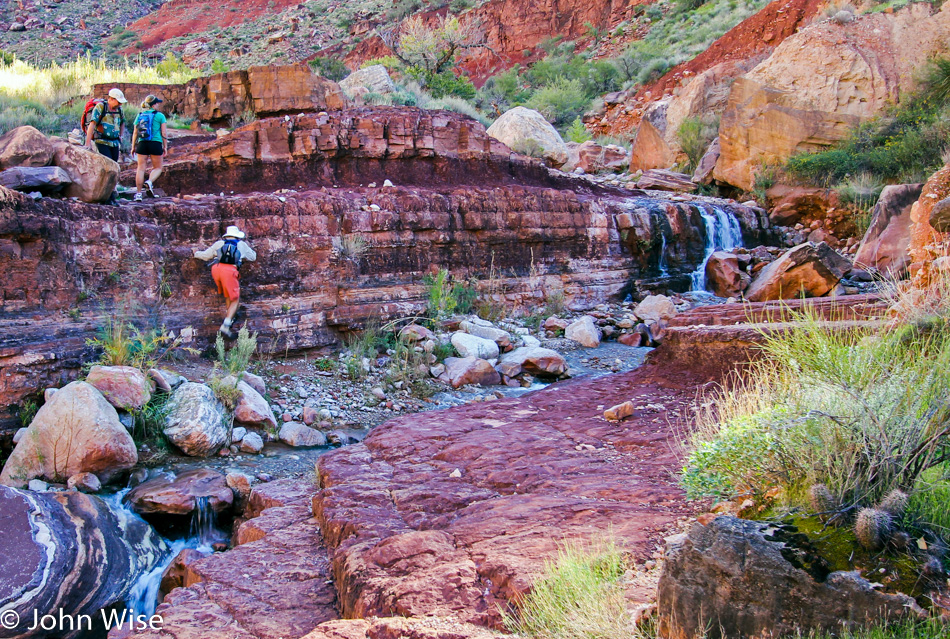
What’s wrong with these speed demons hiking up front? Can’t they read nature’s stop sign? Don’t they know they are supposed to gawk every once in a while? Is my sense organ that is tuned for astonishment that much stronger than those of the people I am traveling with? I try to reassure myself that I am not an alien from another dimension, operating on a different plane of time. For all I know, their powers of observation are so finely tuned that the story they are writing will make my own descriptions and enthusiasm look like a child’s primer. I’ll have to settle with the idea that they are microwave ovens of sight and remembrance, and I am the slow-cooking crock-pot creating depth and rich flavor.

Hey, you cloven-hoofed half-goats, I think Caroline and I will just stop right here at the second waterfall. The others let off an enthusiastic “Maaah!” and, defying gravity, dart up a vertical wall out of sight. Well, here we are, alone. Just us and the waterfall. And some hanging gardens. And all these colorful pebbles, stones, and boulders. And the water running over polished multihued rock faces with minuscule plants growing out of tiny cracks, crevices, and pits in the surface of really big stones. Just the two of us and all of this nature. Alone, surrounded by this unknowable spectacle of the universe, right here, on a rock in the quiet of the morning. Contented, I sigh.
The bluish light of the early morning fades as the sun moves into its position of prominence in the sky. The still cold, gray shadows are in stark contrast to the already radiant patches of ground that are the first to receive the warmth of the approaching sunlight – soon, the shadows will be no more. Golden tones will briefly paint our oasis until the full spectrum of our star returns to bleach the landscape with scorching white light. The Sun and Earth around me rejoice in meeting once again with a display of their well-rehearsed dance of illumination. Stone monoliths surrounding us maintain their silent vigil, looking over these human forms crawling below them.
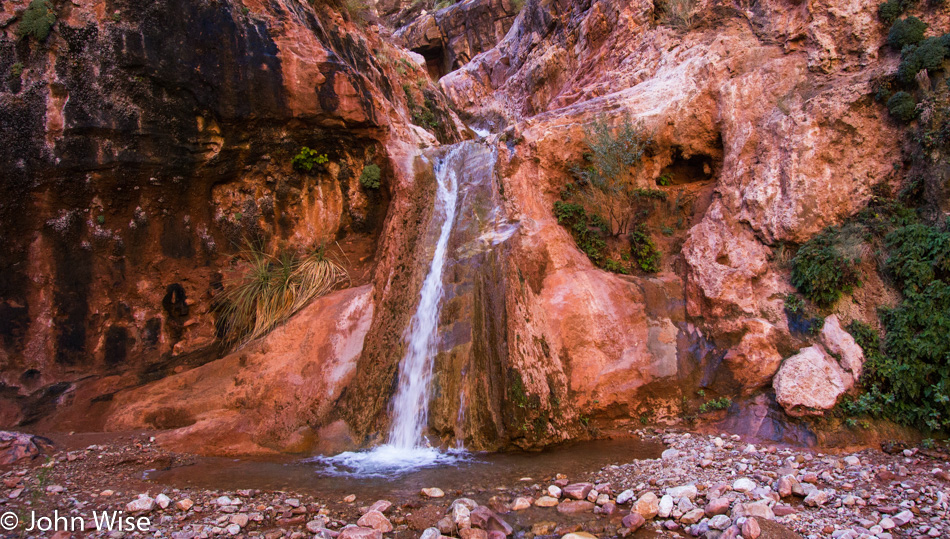
Slicing between stone and sun, running over the Shinumo quartz, the flow of the second waterfall deposits its calcium carbonate soup, slowly, imperceptibly forming the travertine that brackets the falling water. Strewn about the ground are rocks, pebbles, and stones, which have been delivered by a succession of storms, whose quick-flowing torrents hauled these loads of debris from higher in the canyon and ejected them over the waterfall. Do the native rocks see this intrusion of foreign stones and boulders as so much litter cluttering their front yard? To our eyes, this all looks like a well-orchestrated and expertly designed work of art. With these irregular shapes and rough surfaces, this is not the nature modern man would design. Where chaos reigns, too often, our compulsion is to flutter about putting things in order, to align, and make homogenous what the efforts of time have so patiently given us.
We try to sit here like rocks, still and silent, but it’s difficult to stay in one place. With so much detail jumping out to greet our eyes, begging isn’t required to encourage us to go on over for an up-close and detailed examination – of everything. We enthusiastically oblige and, upon approaching these little spectacles, find ourselves falling into delight as shifts in angle and height perspectives reveal yet more of what could have remained unseen had we continued the trek up the trail. Walking to and fro, I hover about the second waterfall of Stone Creek like a moth attracted to the light. As I take note of a plant growing out of the face of a rock, it is as if my peripheral vision is being tapped on the shoulder to look over this or that way, with my feet controlled by curiosity and willfully delivering me to another vantage point. I can accept that we did not see what the others will have gazed upon at their stop and that another potentially incredible corner will remain unknown to us, but I am satisfied that this extended visit offered us a wealth of detail that would have never become familiar without allowing time for this sojourn.

I don’t know how long we sat there, how much of the whole we looked at, or how far we walked around this place under the waterfall, but lunchtime came and went before we finally packed up and left. Not that we really wanted to leave, but we didn’t want the rest of our group to come up from behind and push us along back to camp. We were determined to take the leisurely trail, not the race track. And for our effort to separate from the cozy little spot under the falls, our way back was now in full sun. The Canyon walls were illuminated, the flora deep green, and as the temperature climbed into the low 80s, it felt downright hot.
Almost left unseen, held fast to a giant boulder and blending in perfectly on the bottom side of an overhang, we spot nests, dozens of mud wasp nests. These hanging cells are protected nurseries camouflaged by an ingeniously color-matched and stealthy design. On closer examination, it becomes apparent that no wasps are currently residing here and that we are safe to look around. As I peek into the tiny structures, it dawns on me how similar these nests are to the granaries built by Native Americans across the southwest. Tucked up under an overhang, protected from the weather and predators, hidden by the mud that blends into the surroundings so as not to be easily seen from a distance, these earthen cells are very effective in protecting their precious contents, be it seeds or – in this case – larvae.

Further along this desert trail, we see that we are not the only ones out here in the sunshine. A tiny toad hops off the path and out of the way in haste, exerting some effort to avoid the feet of us approaching giants. Its sunbath is interrupted, and the little guy is anxious to leave the stage. No matter how slowly or gently I move closer, this amphibian is not interested in putting on a show and quickly disappears under some brush. Nowhere near as shy is a lizard sitting tall upon a cairn, inches closer to the heat source that warms its cold reptilian blood, giving it the zip necessary to quickly dart away from swooping birds looking for a snack.
There is a phenomenon we desert dwellers never tire of, while those of you who live in a lush green environment may not be able to appreciate our perspective in quite the same way: Shades of green. It happens more often than not: people enter the vast expanse of deserts in the southwest for the first time and see nothing but an endlessly empty landscape painted with a fat paintbrush of tan and more tan, devoid of life. Barren rock, hot sand, skeletons of long-dead cactus, and that impressive thermal flow of shimmering heat rising off the desert floor, known as a mirage. The new visitors may even ask themselves, “What brought me here in the first place?” But after a while, like eyes adapting to the darkness of night, they start to see details that weren’t there at first glance.

The eyes tune in to subtle shades of green found scattered about on the scorched earth. Thriving cacti and low, silver-gray bushes eke out an existence in the desolation. Keep looking, and sooner or later, you’ll find a mesquite tree. Its dark, rich brown bark adds much-needed contrast to this bleached world. Should you come across a palo verde tree out here, you have found the mother lode of fluorescent green, and in bloom, the top of the tree will be ablaze in sun-bright yellow flowers. From here, we branch into the other desert colors, gradually learning to differentiate the shades of tan and brown, finding oranges, reds, purples, rusts, and greens so deep they are almost black, along with variations of copper, silver, and gold that are moving into focused appreciation. All of a sudden, you wonder how you missed all of this back on your first encounter with a space that looked frighteningly empty.
Over time, the rest of our senses join our eyes in this dramatic transition, allowing us to appreciate having taken up dwelling in this seemingly inhospitable wasteland. Fine, delicate sounds find our ears until we are able to hear the scurry of lizards and the flow of wind over cactus needles. Then, one day, after spending a good amount of time learning how amazing the desert is, you are ready for an entirely new perspective – it rains. And when it does, everything changes. That silver-gray bush explodes in a scent, screaming: “This is the smell of the desert here in the Southwest; this is creosote!” It is the intriguing fragrance that tells you that you are at home.
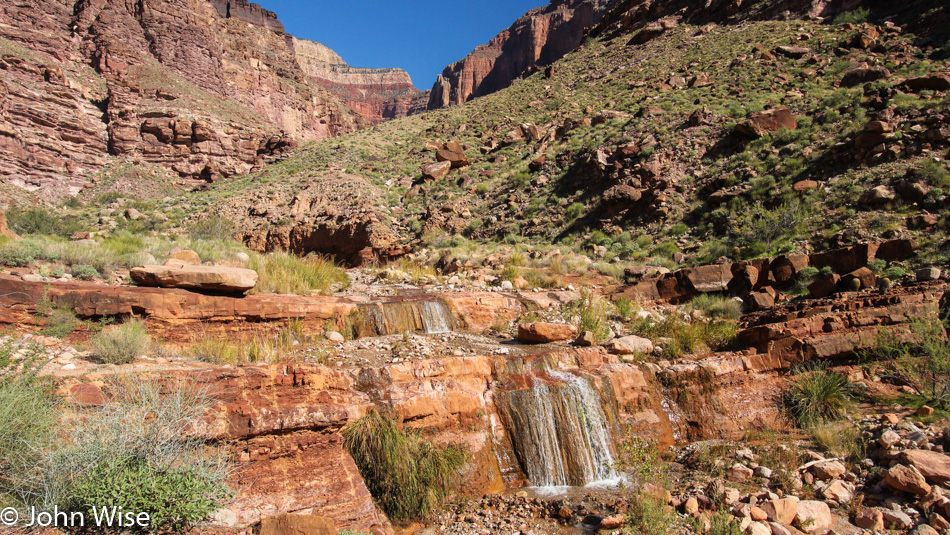
Maybe because this is a desert, the horizon looks fantastically large. An occasional mountain or hill appears squashed under the oppression of a sun that pushes surface temperatures to the burning point. There are rarely enough clouds to fill such a vast expanse, forcing the desert to be satisfied with rain falling on small strips and patches. For those of us lucky enough to put ourselves out there, the play of the weather couldn’t be better. As it rains and lightning bolts throw down, thunder rocks hard, performing its bombastic concert, but just over to the east, or the west, maybe the north, could be to the south, blue sky cuts through the billowy clouds and sharply defined sun rays beam down like a cleaver slicing into the earth. The water that has poured from above quickly saturates the thin, crispy soil to become a flash flood that spreads out and disappears almost as fast as it arrived.
In the rain’s wake, over the following days and weeks, there is a sudden explosion of color. Cacti bloat from the indulgent and rare sip of water offered by the downpour, turning a brighter shade of green. They bloom with white, yellow, red, and purple waxy flowers attracting all manner of insects and birds. Grasses sprout and give it their all to move from seedling to maturity in order to leave their seed for the next generation and the next rain. For a brief time, the desert has a succulent new vibrancy; it glows in electric Technicolor. This spectacular show of life awakening out of dormancy is bedazzling.
It is precisely this weather aftermath that we are walking through today along Stone Creek. At the start of our journey, we had anticipated the browns and tans that could be expected down on the desert floor of the Canyon, but recent rains have given life a boost of water-induced growth to alight our senses in celebration of this rapture of green. There is a humorous side note to this visual stimulation. In previous years, as we were becoming familiar with the desert, we entertained thoughts that we had been witness to the full spectrum of green, but it wasn’t until we found ourselves in the forests of Kentucky or Oregon that we realized that our desert green – even in bloom – is a pale representation of the resplendence of the greens found in areas that receive year-round precipitation. Maybe our green is only truly appreciable to eyes conditioned by this hard-baked, mostly dry sand-and-rockscape.

Drifting in a daydream, our thoughts must have wandered off, and our feet, too. Who stole the trail? A little backtracking, and we are once again on the primitive goat trail we were traveling earlier in the day. Try as we might to see what the boatmen see; as they appear to retrace a well-worn and known path, we often fail to spot where the next step should be put down. Out here on our own, our trail scouting skills fall short of being truly adequate. Of course, the river must be in front of us somewhere, even if we cannot hear or see it yet. So we are obviously pointing in the right direction, and while common sense says: “Follow the creek bed,” that is not always as easy as it might seem due to steep ledges and paths that look like trails but are actually roads to nowhere. Add to this our innate ability to be easily distracted by shiny objects, or even dull ones, and soon we are again off the trail. Maybe we are succumbing to sun poisoning and are too delirious to maintain our focus. Nah, we are mostly lost in our imaginations, wanting to look at everything, wishing for more time.
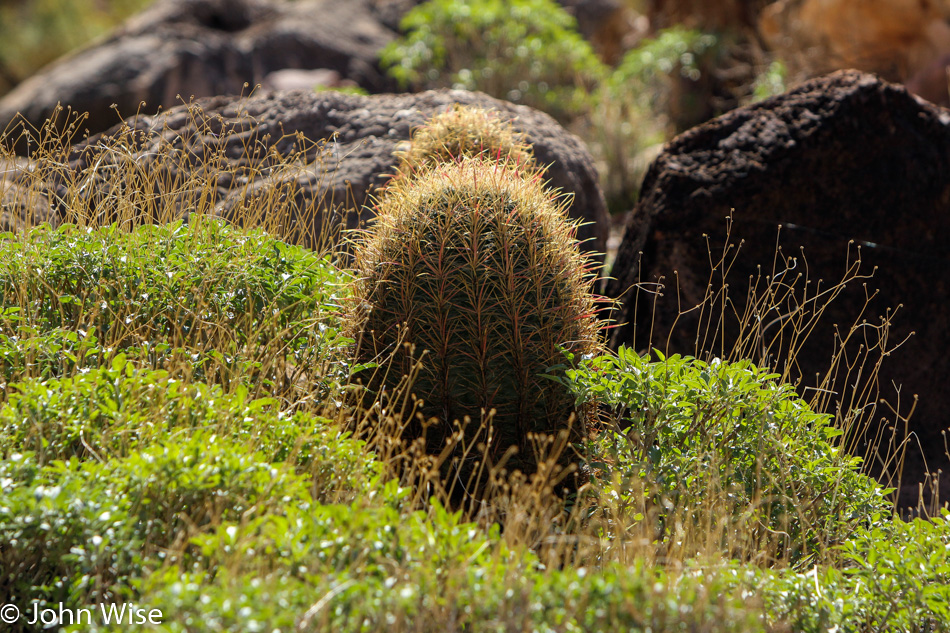
There is a competition going on between Caroline and me to distract one another from the most amazing thing ever, with an invitation to come over and look at this other most amazing thing ever. Our ideas of what has eclipsed the sense of novel beauty are open to discussion, one not easily resolved. What the other one of us has found should be considered equally amazing in order to eliminate the friction of competition, even if I know that what I saw was, in fact, more brilliant, more dazzling, simply…more amazing. On our visits to the Pacific Coast, this isn’t a problem, as we are usually strolling some long, open beach with plenty of distance between us. The loud crashing surf overpowers our voices, allowing us to wander alone in our thoughts and the sound of the sea. But here in the Canyon, even if we drift off to find some space between us, voices echo and easily bring us back together. We share in what the other has found so stunning and can appreciate that it demanded the attention of our own special moment, delving into awe. Down here, we are joined at the hip and joined at the smiles, too. Eleven days into this, and still, we pinch ourselves at our luck that the two of us love and appreciate equally where we are, what we are doing, and one another.
Time to quiet the romantic chatter starting to fill my head and find the trail so we don’t look as amateurish as we are. And who is going to be witness to our feeble trail skills? This group of people we travel the river with, who are rapidly gaining on us, that’s who. We could try pretending that we were somehow pushing into new territory, scaling extraordinary heights in an effort to explore remote corners far and wide, but our slow, comfortable pace and lost gaze will certainly look unconvincing. Picking up the pace now won’t impress anyone who sees through our shells to recognize the snails inside. Like the Roadrunner and Coyote, a blur passes us with a pronounced “Meep Meep.” We’d break out the Acme Rocket, if we had one, to show them a thing or two, but we’ll just have to commit the path they took to our memory and try to follow with the hope of reaching camp by nightfall.
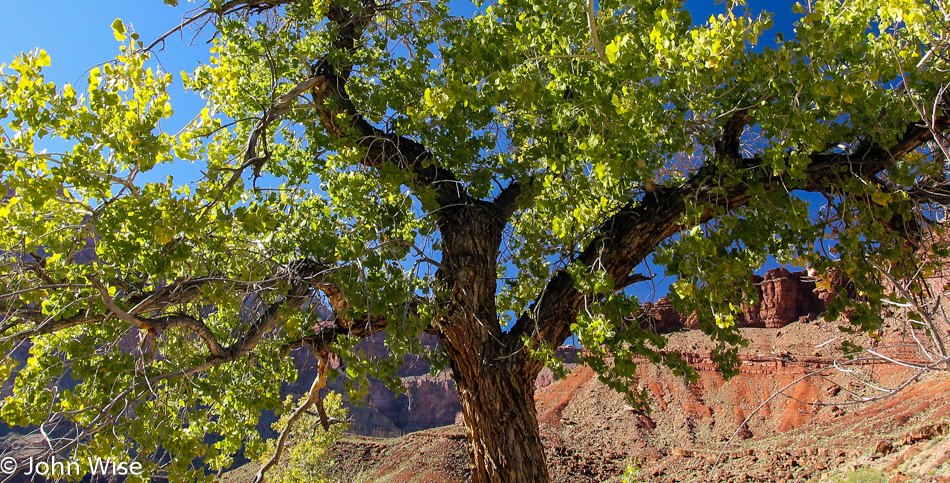
A word or two should be shared about Stone Creek itself. This is a delightful creek of clear water cascading over rock and sand. In places, it has run for so long that it has carved bowls, small flumes, and curvy twisting shapes that swirl, splashing water into small vortices, spinning in the channel it flows through. Along the way, we pass a few small waterfalls and a larger one known as First Waterfall. I suppose I don’t really know what qualifies as a waterfall, as when we were on our way to Second Waterfall, I’d swear some of these other falls would have been considered as such, which might have then put us at Fifth or Sixth Waterfall, but what do I know? I am not a geologist, hydrologist, or any other -ist of importance besides tourist. Walking along, enjoying the afternoon, we stop at another of the water-carved sluices where the creek is flowing with a hypnotic rhythm, gluing us to the spot where we stand until something snaps us from our trance and puts us back in motion.

Finally, we are once again in camp. We are hot, dusty, sweaty, and probably not just a little stinky. It would be a shame to put this funky body into those fresh, clean clothes that we worked so hard yesterday to wash in the muddy water of the Colorado; this requires a bath. Before plunging into the river, I can imagine, even savor, how refreshing my second Grand Canyon bath is going to feel. Stripped to my drawers, I’m ready to go big and let the grime of the last days dissolve into the already muddy waters that will hide my addition to the murk.
Here I go. Holy cow! That’s a whole lot colder than my enthusiasm said it would be. With the ankles and toes abundantly clean, I struggle to convince the calves that they, too, want to shine and sparkle. Before I can slither away to avoid this torture, my own personal fragrance of persuasion finds my nose, insisting I bring what reeks below to this come-to-water meeting. The cold buckles my knees; the air is compressed from my lungs, and I struggle to take deeper breaths. Maybe this convulsive shiver is a final desperate act calculated to deprive the brain of oxygen, bringing on a panic to force a premature exit from these frigid waters. But the heart comes to the rescue and will have none of this wimpy behavior, and with a short, sharp burst of bravado, I squat deeply to allow water to reach those parts that need this bath a lot more than my ankles and knees. That I didn’t pass out from the shock surprises me, although I was left impressed at how quickly that stuff down there leapt up to the warmth behind my navel. Human anatomy obviously works miracles. Out of the water, I do my best to wrap up in my warm and cozy postage-stamp-sized camp towel. My nose assures me this was all for the best.
An early finish to the day with plenty of sunlight remaining was an opportunity for just about everyone to take a dip on the far end of camp, if not to wash up, then to cool off from the surprise heat that had crept up. Moving quietly about, our fellow passengers seem to be organizing their tents and bags in an attempt to put things in order. Maybe they are taking inventory and calculating how things will be packed up for tomorrow’s return to the river. Finished, we gravitate towards the fire pit to talk, drink, write, or find ourselves lost in the sunset.

Our layover is approaching its end, and as if to punctuate the occasion of these two relaxed days, we are offered a celebratory feast of pure Americana. Barbecued burgers and bratwurst with all the fixings, coleslaw freshly chopped and prepared in camp, and baked beans. The great American barbecue, on a great American river in one of the greatest National Parks – the Grand Canyon. Life is good; who could ask for more? Okay, here’s more: it’s called the icing on the cake; well, it’s actually on the bottom, and we call it pineapple upside-down cake. We have scored another of those Dutch oven camp wonders, baked fresh before our eyes and noses.
Our group pulls in closer around the fire for some storytelling while the majority of the crew retires early. The entertainment duties are hoisted upon the shoulders of one boatman, Bruce, our impassioned speaker for the evening. The subject is Lake Powell and the environmental issues of building dams. Tonight’s topic is poignant, as later this evening, the engineers who operate Glen Canyon dam will be ending a two-month steady flow release of water.
The steady flow study is called Beach Habitat Building Flows, or BHBF. In this experiment, scientists are working to understand shoreline erosion and how beaches are faring within the Grand Canyon. They are examining how sediments are being distributed within the river. By varying water flow over measured periods of time, they can analyze the dynamics affecting the ecosystem of beach health and sediment accumulation.
The reason behind this experiment in water flow is that Lake Powell has turned into a sediment pond behind Glen Canyon Dam. This giant body of water pulls in the equivalent of 100,000 train cars of sediment a day. The majority of deposits end up near the head of the lake, at the opposite end of where the dam is. Before dams were built on the Colorado, the river carried the silt-laden waters to the sea, building up shores and beaches along the way. Today that is no longer happening; only the occasional trickle of water reaches the vast Colorado River Delta in Mexico. While this has implications for the viability of the delta, it also has a direct impact on everything from the life span of the many dams that will ultimately be holding more sediment than water to the quality and even the existence of riverbanks and beaches within the Canyon for us visitors to camp on.
Because the water released from the dam is sediment-free, the only sources for maintaining the beaches along the Colorado River are the various tributaries feeding the river, along with the monsoonal floods that wash debris down the Canyon walls. Under normal conditions, many of the tributaries run clear, but when they do flow full of mud like the old Colorado described by J.W. Powell as “Too thick to drink, too thin to plow,” only then might we see beach building events.
That 1983 Canyon flood mentioned earlier not only helped build Crystal Rapid into a monster, it also started stripping away much of the sand that made wide beaches available to people running the river and the many hikers who scramble over the rough terrain looking for that special place to enjoy some camping next to the Colorado. What little sedimentation was left in the Canyon was quickly washed about 260 miles downstream into Lake Mead, the next sediment pool on the Colorado.
Back in 1991, Bruce had the opportunity to run the Green River from the town of Green River, Wyoming, to its confluence with the Colorado in Canyonlands National Park. From there, his journey continued through Cataract Canyon, where the river disappears into Lake Powell. Bruce rowed across the lake before rejoining the river in the Grand Canyon below the dam and finishing this adventure on Lake Mead above the underwater Mormon town of Callville, Nevada. Bruce wasn’t alone; traveling with him on an important 12-day leg of this 42-day river trip was Luna Leopold. His name isn’t easily recognizable, but his legacy and his lineage are worth noting. Luna was the son of the famous environmentalist and author of A Sand County Almanac, Aldo Leopold. Continuing his father’s commitment to conservation and the ecological conscience, Luna, whose formal training was that of geomorphologist (the scientific study of landforms), had been involved with a study referred to as the Colorado River Storage Project or CRSP as far back as the 1950s.
Luna, aged 75 at the time of the 1991 trip, was here to read the river depths and study how sedimentation might affect the dams holding back the mighty Colorado. This was controversial science then, and it is still controversial today. In question is the health of these dams and their consequences. The engineers who designed these corks thought they were building 500-year legacies to their engineering prowess; what the natural sciences were telling them was you may have 200 years of use of these dams, and possibly even less than that.
It was near the Hite Bridge, part of Utah State Route 95, that Luna was noting river depths of about 8 feet. Near the junction with the Dirty Devil, almost 3 miles downstream from the bridge, Luna’s readings were still showing a depth of about 8 feet, but soon he would find the shocker. His depth readings showed a precipitous 200-foot drop – to the old river bed! The head of Lake Powell was filled with a giant sediment plume! Today, this plume has extended its crawl forward and is now about 2 miles further downstream.
If this has you wondering, how does a lake full of sand affect me? The answer is quite simple. The Colorado River, as it winds its way out of the Rockies, picks up and carves away many soil nutrients, which are suspended within its silty waters. Prior to the creation of the series of dams that now impound the river and distribute its waters to farms, golf courses, swimming pools, and fountains all over the Southwest, it flowed uninterrupted down to the Colorado River Delta south of Yuma, Arizona, before pouring into the Sea of Cortez. Not only is the river delta being destroyed, but the nutrient-rich waters that should be flowing to the sea are no longer available to help feed the Gulf of California. This is important because the Gulf is home to the world’s largest animal, the Blue Whale, in addition to Humpback Whales, Fin Whales, Killer Whales, the California Gray Whale, Giant Pacific Manta Rays, Sperm Whales, Leatherback Sea Turtles, and a plethora of other sea life.
Wherever humanity has built dams, we see the impact on the marine life that had once relied upon the rich, fresh waters that flowed over the land. Salmon in America’s Pacific Northwest comes to mind when we think about the difficulties brought on by our altering of the ecological system that not only sustains us but provides for many other species, too. The Aswan dam that holds back the Nile in Egypt is now recognized to be having a negative impact on the fisheries in the Mediterranean. Nutrients such as phosphate and silicate act as ocean fertilizers that sustain the diversity of coastal life, but these land-derived salts will never reach their destination when sequestered behind a dam in a mountain of sediments. Most wild rivers that once ran to the oceans have been stopped in their tracks for our convenience only, not the other lives that depend on these rivers performing their natural role.
Bruce equates these river systems with something very personal: our very own hearts and bodies. He closed his talk with the following, “The planet’s rivers are the nutrient stream; they are the circulatory system of Earth. If humankind continues to build and maintain these constrictions in nature, just as a poor diet can contribute to clogged arteries leading to heart disease, might we be sending our life-sustaining environment off to suffer a heart attack? It may not seem acute to us because we see time in human terms, but beyond our own short lives, life continues to flow. Unless we do something to change our attitude and short-sighted relationship with nature, will we ultimately be the necrotizing disease that significantly damages the Earth? Is it possible that nature is just too big and complex for our limited perspective to fully comprehend and appreciate?
Over 110 years ago in 1900, the investigation to build a dam on the Colorado was undertaken. Back then, humanity hadn’t yet flown in an airplane. Henry Ford’s Model T was still 14 years from hitting the road. Penicillin wouldn’t start fighting infections until 1928. We’ve come a long way since those days, with cell phones that feature built-in video cameras and GPS that receive data from satellites in low orbit circling our planet. Computers are helping humanity decipher our genetic code while simultaneously running the global electronic library of knowledge and culture that we call the Internet. The sun and wind are being harnessed to supply us with more sustainable energy sources, but we require a healthy environment to be able to enjoy these incredible strides forward. It is time for humankind to look at the decisions made on our behalf and recognize that we have progressed forward from our early scientific roots. We can change our world for the better.
There’s nothing quite like the enthusiasm of someone who invested their heart and soul in what concerns them, to motivate and inspire others. Picking up on his passion, we will carry from this Canyon a greater desire to know more about many of the things we will learn during this adventure. Back home, Caroline and I read more than a dozen books about the early navigators of the river, the environmental concerns, and the geologic and fossil history. We joined the Grand Canyon River Guides Association to lend our voices and support to those dedicating their lives to protecting the Canyon. I began a blog entry to share what I found, only to find it growing larger than a few online words as it matured into this book.
–From my book titled: Stay In The Magic – A Voyage Into The Beauty Of The Grand Canyon about our journey down the Colorado back in late 2010.









